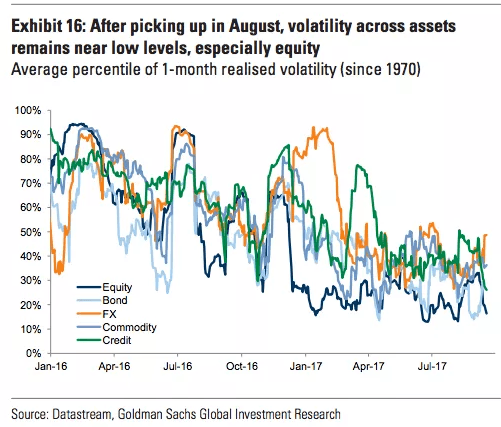Well, the Fed didn’t create much in the way of a vol. spike on Wednesday, much to the chagrin of the folks who decided to pile into UVXY and TVIX ahead of time.

The general consensus – and certainly the Fed’s hope – is that balance sheet normalization will turn out to be just as mundane as Janet Yellen’s characterization (i.e. it will be akin to “watching paint dry”).
While they’re almost undoubtedly keen on taking some of the air out the various bubbles post-crisis policy has helped to inflate, the idea is to let it out slowly, not all at once. If all goes according to plan, the waters won’t get too choppy.

That amid increasingly shrill cries from ostensibly “astute” folks like Heisenberg who stubbornly insist the day of reckoning is just around the corner and could well start with a sudden spike in yields that makes the Sintra mini-tantrum look… well… look “mini” by comparison.
The inescapable reality, however, is that with each passing day of still-suppressed vol., the doomsayers look more Chicken Little-ish than they did the day before.
That’s the backdrop for a new piece by Bloomberg’s Cameron Crise who has “good” news for the vol. longs: assuming we can divine anything meaningful about the long-term from the dots, those betting on a vol. spike will be vindicated in no time. Where “no time” means three years from now. More below…
Via Bloomberg
Traders have become so accustomed to a dovish FOMC, even when it’s tightening policy, that they seem to have forgotten what a hawkish Fed actually looks like. Wednesday’s statement and summary of economic projections offered a reminder, with the crucial 2017 and 2018 dot plot medians remaining unchanged…projecting another 100 bps of rate hikes by the end of next year. Moreover, the economic projections showed little concern over any long-term implications of this year’s hurricanes and retained belief in the Phillips Curve, albeit in a slightly weakened form. Perhaps most intriguingly, the Fed offered a glimpse of the future in which policy is actually restrictive. Fear not, volatility worry-warts…the Fed’s got your back in 2020.
While the FOMC statement acknowledged the short-term impact of the recent hurricanes, they drew on the historical evidence to look through the disruptions in assessing the medium-term trajectory of the economy.
Crucially, the 2017 and 2018 dot plot medians didn’t budge, with most committee members holding the line at or above the prior median levels. That’s a sharp contrast to market pricing…though in line with most economists’ projections. While there has been some adjustment in market pricing as a result of this revelation, OIS and Fed funds futures are still being very conservative in calibrating the Fed’s cycle–largely as a function of the uncertainty surrounding the economy and committee going into next year.
It is true that the long-run rate median was marked down, from 3% to 2.75%. This was in line with recent rhetoric, and in any case still far above the terminal pricing embedded in the OIS and eurodollar markets.
What’s particularly notable, however, is that the freshly-minted 2020 dot plot median was 2.87%…above the Fed’s perception of the long-run neutral rate. In other words, the dot plot projects that policy will actually get restrictive in 2020!
Of course, it’s important not to read too much into such long-term projections. Many of the current participants will not be around to vote on policy in three years. Moreover, a lot can change between now and then, so this projection clearly isn’t etched in stone.
But restrictive policy is the stuff of economic volatility…and by extension, market volatility. For the Fed to include such an outcome in their projections is clearly hawkish.
That doesn’t mean that vol will necessarily rise today, of course. After all, policy is still accommodative. But it does serve as a nice reminder that as policy gradually and inexorably moves towards, and perhaps beyond, neutral, vol will eventually rise.
So hang in there, volatility longs. Only three more years ’til it all goes horribly right!

Heisenberg Report. "I am the one who knocks"
Recommended Content
Editors’ Picks
EUR/USD edges lower toward 1.0700 post-US PCE

EUR/USD stays under modest bearish pressure but manages to hold above 1.0700 in the American session on Friday. The US Dollar (USD) gathers strength against its rivals after the stronger-than-forecast PCE inflation data, not allowing the pair to gain traction.
GBP/USD retreats to 1.2500 on renewed USD strength

GBP/USD lost its traction and turned negative on the day near 1.2500. Following the stronger-than-expected PCE inflation readings from the US, the USD stays resilient and makes it difficult for the pair to gather recovery momentum.
Gold struggles to hold above $2,350 following US inflation

Gold turned south and declined toward $2,340, erasing a large portion of its daily gains, as the USD benefited from PCE inflation data. The benchmark 10-year US yield, however, stays in negative territory and helps XAU/USD limit its losses.
Bitcoin Weekly Forecast: BTC’s next breakout could propel it to $80,000 Premium

Bitcoin’s recent price consolidation could be nearing its end as technical indicators and on-chain metrics suggest a potential upward breakout. However, this move would not be straightforward and could punish impatient investors.
Week ahead – Hawkish risk as Fed and NFP on tap, Eurozone data eyed too

Fed meets on Wednesday as US inflation stays elevated. Will Friday’s jobs report bring relief or more angst for the markets? Eurozone flash GDP and CPI numbers in focus for the Euro.